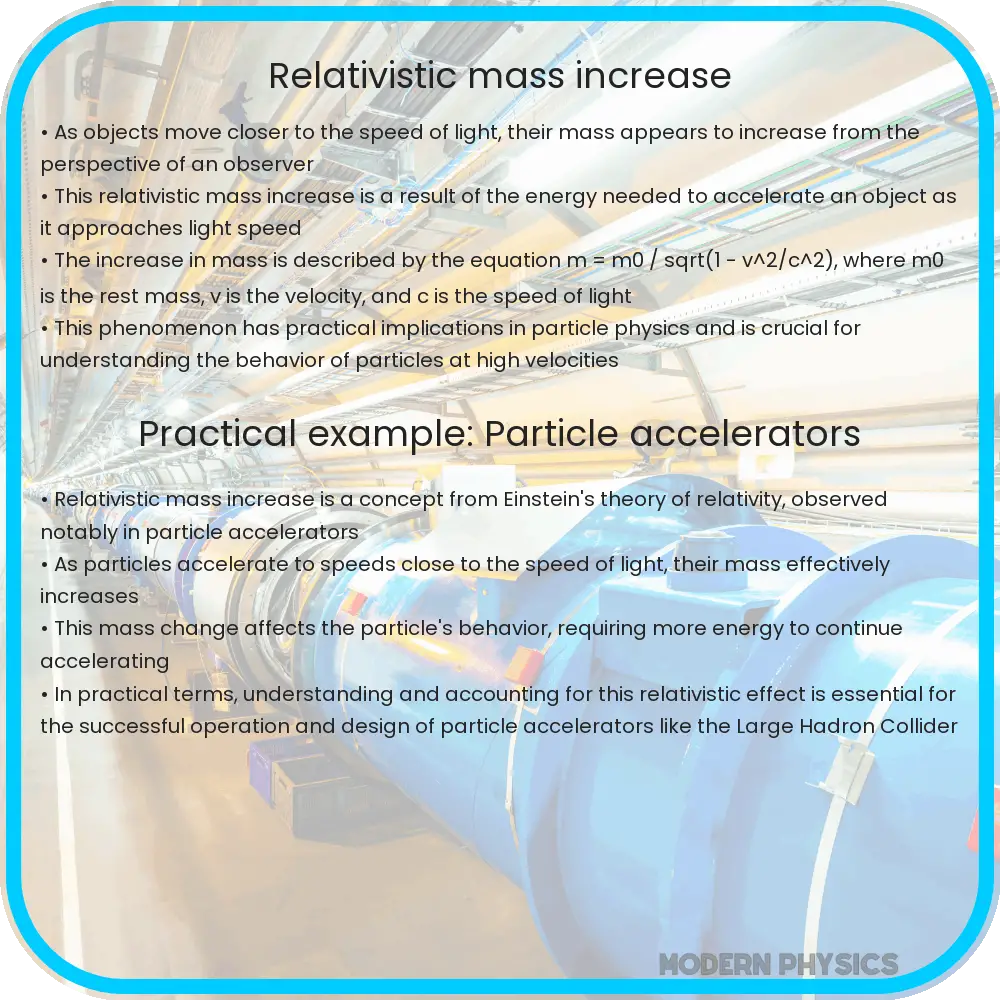Learn how Einstein’s Special Theory of Relativity leads to mass increasing as objects approach light speed, impacting physics’ understanding of energy and momentum.

Understanding Relativistic Mass Increase
One of the startling predictions of Albert Einstein’s Special Theory of Relativity is the increase of mass as an object moves closer to the speed of light. This phenomenon, referred to as relativistic mass increase, has profound implications in physics, particularly in understanding speed, energy, and momentum at high velocities.
The Basics of Relativistic Mass
At speeds much lower than the speed of light, an object’s mass appears constant and is typically called the “rest mass” (m0). However, as the object’s speed approaches the speed of light (denoted as c), the relativistic effects become significant. According to relativity, the mass of an object increases with its speed according to the formula:
m = m0 / sqrt(1 – v2 / c2)
where:
- m is the relativistic mass
- m0 is the rest mass of the object
- v is the velocity of the object
- c is the speed of light in vacuum (approximately 299,792,458 m/s)
This equation shows that as the velocity v approaches the speed of light, the denominator approaches zero, making the relativistic mass m approach infinity.
Relativistic Speed and Energy Connection
The increase in mass is directly related to the increase in energy required to accelerate the object. As an object’s mass increases, more energy is needed to continue its acceleration, leading to one of the most famous equations in physics:
E = mc2
Here, E represents the total energy, m is the relativistic mass, and c is the speed of light. This equation highlights how mass can be converted into energy and vice versa, a principle that is crucial in fields ranging from astrophysics to nuclear energy.
Implications on Momentum
Momentum, a measure of the motion of a body, is also affected by the speed. In classical mechanics, momentum (p) is calculated by the product of mass and velocity:
p = mv
However, under relativistic conditions, as the mass varies with speed, the expression for momentum has to be modified to:
p = m0v / sqrt(1 – v2 / c2)
This modified version takes into account the increase in mass with velocity. As velocity approaches the speed of light, the momentum of the object increases significantly compared to what would be predicted by non-relativistic physics.
Physical Observations and Practical Applications
The effects of relativistic mass increase are not noticeable in everyday life because they only become significant at speeds close to the speed of light. However, in high-energy physics, such as in particle accelerators, these effects are crucial for understanding the behavior of particles moving at high speeds. For instance, in particle accelerators like the Large Hadron Collider (LHC), protons are accelerated to speeds close to that of light, dramatically increasing their mass and hence, the energy levels achievable during collisions.
In such extreme conditions, the predictions of relativity are consistently confirmed, showcasing the robustness and accuracy of Einstein’s theories.
Challenges and Considerations in Engineering
Understanding relativistic mass increase is not just a theoretical pursuit but also has practical implications in engineering, particularly in the design of particle accelerators and spacecraft propulsion systems. Engineers must consider relativistic effects when dealing with objects moving at speeds where these phenomena become non-negligible.
In the realm of space travel, for instance, as we venture farther into space and contemplate reaching speeds closer to the speed of light, engineering solutions need to account for relativistic effects on mass and energy. This includes everything from the structural integrity of spacecraft to the calculation of fuel requirements and navigation systems.
Educational Impact
Relativity also plays a crucial role in education, particularly in physics and related fields. It challenges students to think beyond the Newtonian mechanics that describe everyday phenomena and to embrace more complex theories that explain the broader workings of the universe. By understanding relativistic mass increase, students and researchers can better appreciate the connected nature of mass, energy, and speed at a fundamental level.
Conclusion
The concept of relativistic mass increase is a fascinating result of Einstein’s theory of relativity, revealing deeper insights into the nature of matter and energy. This phenomenon might seem abstract because it operates on scales far removed from human experience. However, its implications are profound, influencing everything from the fundamental laws of physics to practical applications in high-energy physics, space travel, and beyond. As our technological capabilities advance and we push the boundaries of speed, the principles of relativistic mass increase will become increasingly relevant, not only in theoretical physics but also in practical engineering applications. The journey through understanding and applying Einstein’s insights continues to be one of the most exhilarating aspects of modern science and engineering.
